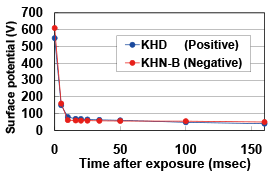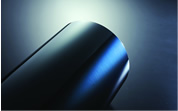| Features |
 |
 |
 |
High Hardness, Long Operating Life |
|
 |
 |
 |
From a consumable to a non-expendable item
Amorphous silicon photoreceptor drums are long-life and highly durable products changing the role of the photoreceptor drum from a consumable to a component with a long product life equivalent to a printer’s life.
Newly developed “MSdrum®”
Kyocera is the first manufacturer to have produced drums with an a-C surface layer on an industrial basis in the world. The new development, “MSdrum®”, realizes high-durability with no heater by adopting an a-C surface layer, which is excellent in terms of hardness and oxidation resistivity.
Kyocera's a-Si photoreceptor is much harder than conventional photoreceptors, therefore a-Si drums possess superior abrasion resistance. A comparison of standard photoreceptors' printable sheets of paper is indicated in the following table. |
 |
|
Se Type |
OPC Type |
a-Si Type |
| Printable sheets of paper |
500,000-
700,000 sheets
|
Up to one million sheets |
Up to 5 million sheets |
 |
(Drum size: O.D.100mm; printable sheets of paper: printing A4 sheets in a transverse direction)
* Based on research by Kyocera. |
 |
|
 |
High Speed Stability |
|
 |
 |
 |
| High speed performance realizing high speed printing |
 |
Response speed is no longer than 15m/sec. Moreover, blade cleaning can be performed at 1m/s or even faster.
a-Si drums demonstrate the best performance with high speed machines.
|
|
 |
 |
|
|
 |
 |
 |
 |
|
 |
 |
High Reliability |
|
 |
 |
 |
| High reliability realized through inorganic materials |
 |
a-Si drums are composed of sectional layers and do not experience much characteristic changes in their durability due to the highly stable substances utilized for each layers.
Also, the drums do not deteriorate from the use of solvents or by heat.
|
 |

*“MSdrum” is a registered trademark of Kyocera. |
|
|
 |
High Image Quality |
|
 |
 |
 |
| From office-color applications to printing presses |
 |
| A high definition image is achieved by the resolving power of the a-Si drum and also our uniqne high-precision processing technology. |
|
 |

|
|
 |
 |
 |
|
 |
 |
Resource Conservation /
Less Environmental Burden |
|
 |
 |
 |
| Ultimate ECO. “Reduce.” |
 |
Recycle, Reuse, and Reduce. The Kyocera a-Si drum will help users produce environmentally-friendly products and reduce waste materials.
|
|
|
|
 |

| Applications |
 |
|
 |
ECOSYS Printers |
|
 |
| In the office printer market, the ECOSYS Series has a non-cartridge design with a-Si drums that do not need to be frequently replaced during the printer life cycle. Thus, the ECOSYS Series balances eco-friendliness and the lowest possible costs per page. |
|
 |
| ECOSYS printers are highly regarded for their eco-friendliness, becoming the first office printer to win Japan's “Eco Mark.” Furthermore, ECOSYS printers have received Germany's “Blue Angel,” Canada's “Eco Logo,” Australia's “ACF,” and in July 1999, acquired the first certification as a printer of the “Nordic Swan” known for the highest ecological standard certified by the five Nordic countries.
These commendations are based on the long operating life of the a-Si drums.
|

|
 |
High-Speed Printers
|
|
 |
The reliability of high-speed printers should not be limited to printing stability as ordinary printers are, but to achieving a satisfactory level of results. The regular replacement of consumables, or the temporarily downtime of printers due to maintenance led to reductions in the productivity of printing services.
On the other hand, Kyocera's a-Si drums provide printing services continuously and raise printer productivity thanks to the long operating life and long-term performance, as well as the decrease in the frequency of maintenance required for replacement of components such as the photoreceptor.
Furthermore, a-Si drums facilitate device design for maintenance which suits the user's needs.
The major benefit of a-Si drums is the extension of operating life for high-speed printers which need to complete large quantity jobs in a short period of time.
|
|
|
 |
Liquid Toner Development |
|
 |
As the name implies, liquid toner printers apply liquid toner in place of using powder toner as conventional copy machines and printers do.
While the particle size of powder toner is 8-15µm, the size of liquid toner is 2µm or less, therefore high quality and high-resolution images can be obtained by using liquid toner. Moreover, the thickness of toner on the printed surface is very thin therefore the texture of target sheets can be maintained.
Typically, due to the use of solvents, it is inevitable that the average operating life of Organic Photo Conductor (OPC) drums will be reduced, however, Kyocera's a-Si drum ensure superior performance due to their great durability against solvents.
|
|  |
 |
On-Demand Printing |
|
 |
On-demand printing, as the name suggests, means printing what you need, when you need it, in the quantity you need. Conventional offset printers generally require press plates, which require a certain period of time to create. Moreover, when considering cost-performance, offset is not adequate to print a small number of copies (from several dozen to a couple hundred). In contrast, digital printing presses (on-demand) do not require printing plates, rather, it is possible to print immediately from a computer's output instructions. Therefore digital printing is the most appropriate way to print in small quantities in a short time.
On-demand printing is used for industrial digital printing presses which can realize high-speed, high-quality images, high durability and high reliability. Therefore, Kyocera a-Si drums respond to the demands of the market. |
|
|
|
|
 |
|
| Electrophotographic Process |
 |
 |
 |
Electrophotographic Process |
|
 |
The electrophotographic process was invented in 1938 by C.F Carlson (U.S.A.). Electrophotography is also known as the indirect electrostatic copying method. The basic process composition is as pictured in the figure to the right. First, the photoreceptor is charged, light is applied to the source to transfer the printing data onto the photoreceptor, the electrostatic image is exposed on the surface of the photoreceptor, and then the latent image is visualized using toner. There are two different light sources that are commonly used for electrophotographic imaging.
- LED (using an LED array as the light source)
- Laser (using a semiconductor laser as the light source)
|
|
|
 |
|
 |
 |
| Lineup |
 |
| Applications |
Size*1 |
Series |
Specifications |
Polarity |
Electric
potential |
Printable sheets of paper*2 |
| Drum Diameter |
Drum Length |
| MFPs |
φ30,40 |
A4,A3
(254mm~360mm) |
KMD-B (NEW) |
High quality color MSdrum® |
Positive |
~500Va |
1,000K sheets
(φ30 A4 vertical) |
| KMN-B (NEW) |
High quality color MSdrum® |
Negative |
~-700V |
1,000K sheets
(φ30 A4 vertical) |
| KMR-B (NEW) |
High resolution color MSdrum® |
Positive |
~300V |
1,000K sheets
(φ30 A4 vertical) |
High-end
office use |
φ80
~φ120 |
A3~18inch
(340mm~500mm) |
KHD |
Standard |
Positive |
~500V |
5,000K sheets
(φ84 A4 horizontal ) |
| KHN |
Standard |
Negative |
~-700V |
5,000K sheets
(φ84 A4 horizontal ) |
| KED |
Reduce light interruption |
Positive |
~500V |
5,000K sheets
(φ84 A4 horizontal) |
High-speed
digital
printers |
φ140
~φ262 |
A3~B2 horizontal
(340mm~835mm) |
KED |
Reduce light interruption |
Positive |
~500V |
10,000K sheets
(φ242 14″ paper) |
| KER |
High voltage |
Positive |
~700V |
10,000K sheets
(φ242 14″ paper) |
| KHD-B |
High quality color |
Positive |
~500V |
10,000K sheets
(φ242 14″ paper) |
| KHN-B |
High quality color |
Negative |
~-700V |
10,000K sheets
(φ242“14 paper ) |
Printers for
special
applications |
φ30
~φ120 |
~A0
(100mm~950mm) |
KHD |
Standard |
Positive |
~500V |
5,000K sheets
(φ84 A4 horizontal ) |
| KHN |
Standard |
Negative |
~-700V |
5,000K sheets
(φ84 A4 horizontal ) |
 |
*1 For other specifications which are not described please contact a Kyocera representative.
*2 Based on research by Kyocera. |
|
|
 |
|
 |
|